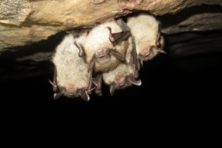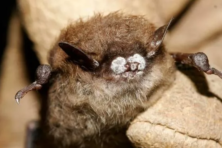White-nosed Bat Syndrome Spreading
- Share
- Tweet
- Pin
- Share
Winter 2016 bat survey results found that white-nose syndrome has spread to new bat hibernating sites in Wisconsin and is starting to decimate bat populations. “We are finding white-nose syndrome on a widespread basis, and the largest sites are all home to the fungus responsible for this disease,” said Paul White, Department of Natural Resources conservation biologist leading the Wisconsin Bat Program. White-nose syndrome does not affect people or other animal species, but causes hibernating bats to frequently wake, depleting their energy and causing them to die from starvation, dehydration or exposure to the elements. Since the discovery of white-nose syndrome in 2006 in New York, upwards of 6 million bats have died and the disease has spread to 28 states. Surveys showed a 94 percent drop in bat populations at the Grant County mine where the disease was first detected in Wisconsin in 2014, and one site where the disease was first found in 2015 had zero bats. Bats are voracious insect eaters, and a 2011 North American study estimated that bats save Wisconsin’s agriculture industry between $658 million to $1.5 billion annually in pesticide costs. Volunteers are needed to count the bats emerging from bat houses and buildings in the evening several times during the summer and for the Great Wisconsin Bat Count, scheduled for June 3-5 and July 29-31. Information and observations from roost monitoring volunteers have enabled the Wisconsin bat program to create a database of more than 200 roost locations and population estimates across Wisconsin, shed light on bat roosting behaviors, and fuel more research. For more information regarding volunteer opportunities, visit the Wisconsin Bat Program website (wiatri.net/inventory/bats/) or contact Paul White at 608.267.0813 or Heather Kaarakka at 608.266.2576.



